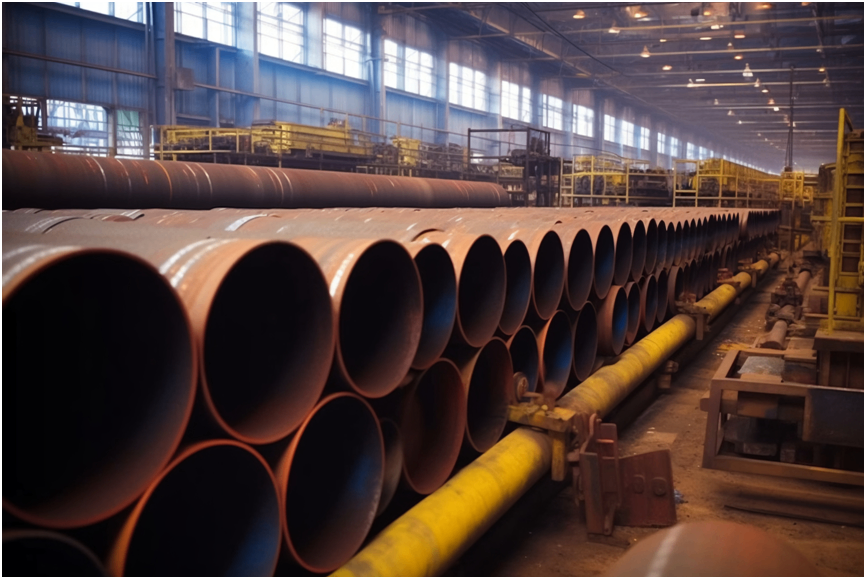In the second quarter of 2025, the global steel market is experiencing a complex situation of mixed long and short factors. As the world's largest steel producer, China's export quotations continue to be lower than those of major competitors such as India and Turkey, but the escalation of trade protection measures in many countries and the downward adjustment of global economic growth expectations have cast a shadow on the trend of steel prices.
Image Source:699pic. com
Trade barriers have intensified, and export space is under pressure
The US's move to impose high tariffs on Chinese steel products continues to ferment. On April 15, the White House announced that it would impose tariffs of up to 245% on Chinese goods exported to the United States. This policy directly impacted China's steel exports. Data shows that China's steel exports to the United States in 2024 have dropped sharply compared with Trump's first term, and this tariff increase will further compress the market space. What is more noteworthy is that trade protectionism has a domino effect: Vietnam imposes a temporary anti-dumping duty of 0-37.13% on Chinese coated coils, Brazil makes a positive preliminary ruling on Chinese galvanized coils, India imposes a 12% tariff on some imported steel products, and Canada, South Korea and other countries have also followed suit. The tightening of this "global tariff network" has forced Chinese steel companies to face a more complex trade environment.
Customs data showed that China's steel exports in March 2025 increased by 5.7% year-on-year, but the new export order index in April fell back to 41.0%, down 0.1 percentage point from the previous month. The short-term export growth supported by this "rush out effect" is difficult to offset the pressure brought by the long-term deterioration of the trade environment. Companies have to adjust their strategies.
Capacity regulation deepens, industry integration accelerates
In the domestic market, the steel industry is undergoing deep structural adjustments. The National Development and Reform Commission continues to promote crude steel production regulation. Crudein 2025 is expected to fall by 2% year-on-year to 986 million tons, continuing the trend of reduction since 2021. The Ministry of Industry and Information Technology revised the "Implementation Measures for Capacity Replacement in the Steel Industry", canceled capacity indicator transactions, and only allowed capacity transfer through substantial mergers and reorganizations. This policy orientation will accelerate the concentration of the industry and promote leading enterprises such as Baowu Group and Angang Steel to expand their market share through mergers and acquisitions.
Capacity regulation and environmental protection policies form dual constraints. The Ministry of Ecology and Environment has included the steel industry in the national carbon trading market, and will enter the carbon emission intensity control stage in 2025. The quota allocation is linked to the emission reduction level of enterprises. Some companies have started technical transformations such as hydrogen metallurgy and short-process steelmaking. For example, although the acquisition of American Steel by Nippon Steel was interfered by political factors, its commitment to introduce low-carbon technology reflects the trend of green transformation in the global steel industry.
Demand differentiation, emerging markets become the focus
The global manufacturing PMI continued to be sluggish, falling to 49.6% in March, and weak external demand directly suppressed steel demand. However, regional markets show differentiation characteristics: the Asian market accounts for 68% of China's steel exports. India's "National Steel Policy" plans to reach a production capacity of 300 million tons by 2030, and its domestic demand growth is in conflict with protectionist policies; Iran plans to increase its steel production capacity to 55 million tons by 2025 and introduce tax incentives to attract investment. Infrastructure demand in Africa and Southeast Asia provides potential space for steel exports, and Djibouti Free Trade Zone and Indonesia Economic and Trade Cooperation Zone have become investment hotspots.
The domestic demand structure is also being optimized. The growing demand for high-end steel in emerging industries such as new energy vehicles and wind power equipment has prompted steel companies to increase their R&D investment. The export quotation of medium and thick plates shows that Chinese products are 23 US dollars/ton lower than those in the CIS, but they still face technical barriers in areas such as automotive plates and silicon steel. This structural contradiction of "low-end excess and high-end shortage" forces the industry to transform to high quality.
Opportunities and challenges in price game
The current global steel market presents a "double squeeze" trend: the supply side faces trade barriers and capacity regulation, and the demand side is constrained by the global economic slowdown and structural adjustment. Chinese steel companies need to find a breakthrough in the cracks. On the one hand, they can avoid trade risks through overseas layout, and on the other hand, they can accelerate technological innovation to increase product added value.
In the short term, the "rush out effect" may maintain the high export volume in May, but the year-on-year growth rate may narrow. In the medium and long term, industry integration and green transformation will reshape the competitive landscape, and companies with technological advantages and global resource allocation capabilities are expected to stand out. In this multi-dimensional game involving policies, markets, and technologies, the steel industry is shifting from "scale expansion" to "quality competition", and its price trend will eventually return to the essential logic of industrial upgrading.

